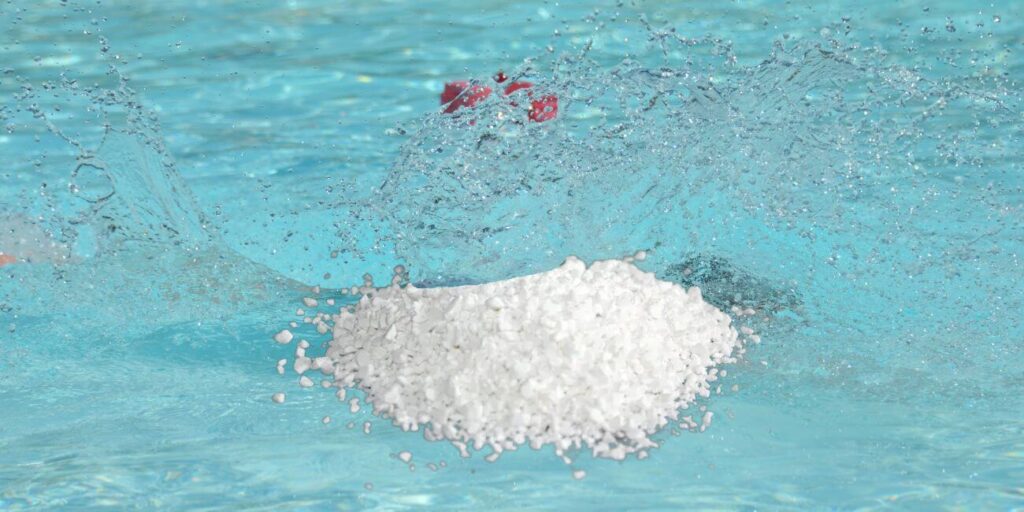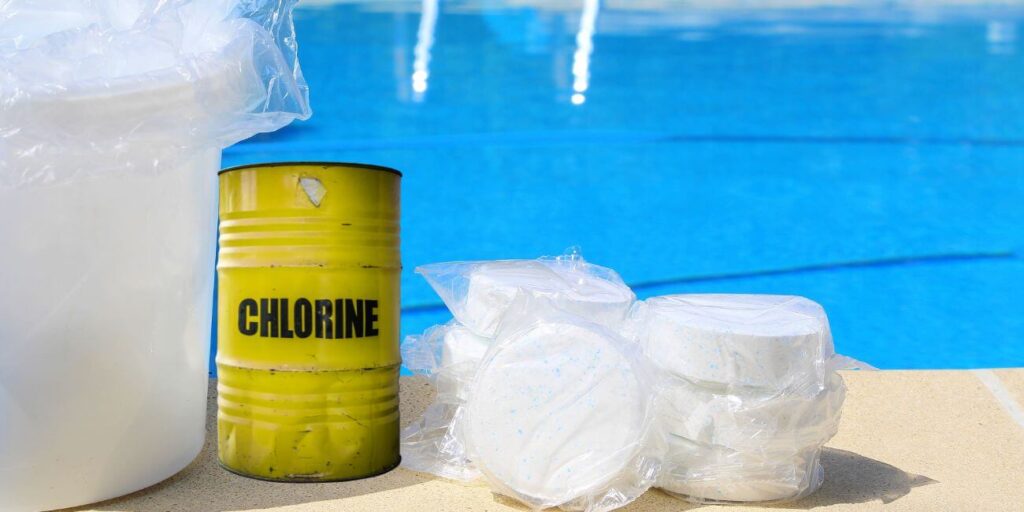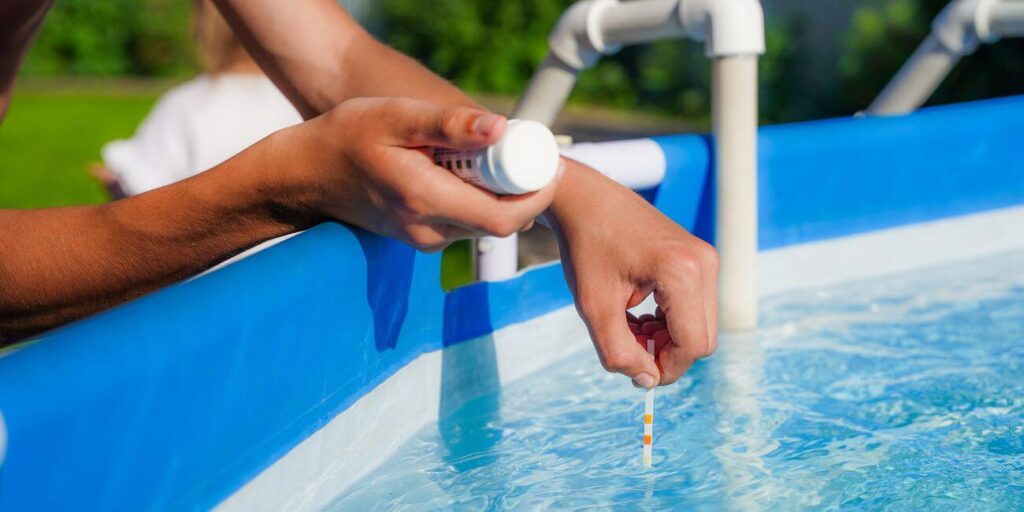Your pool’s cleanliness and safety aren’t something to be argued, and chlorine remains the workhorse when it comes to sanitizing your pool. Whether it’s against bacteria, algae, or cloudy water, chlorine gives the same result every single time. But with the availability of chlorine granules and liquid chlorine, the age-old dilemma plagues the minds of the average pool owners: What’s better?
Table of Contents
-
-
-
-
-
-
- Introduction
- What are Chlorine Granules(or Trichlor Granules) and Liquid Chlorine?
- Effectiveness: Chlorine Granules or Trichlor Granules
- Efficacy: Liquid Chlorine
- How to Use Chlorine Granules?
- Benefits and Drawbacks of Chlorine Granules or Trichlor Granules
- Benefits and Drawbacks of Liquid Chlorine
- Which Is Better? A Detailed Comparison Between Liquid Chlorine and Chlorine Granules
- Conclusion
- FAQs
-
-
-
-
-
Introduction
Chlorine granules, such as trichlor granules or calcium hypochlorite, come as a concentrated solid, whereas liquid chlorine gives you the quick pour-and-go solution. They both disinfect with ease, but their polar opposite in the way of application, efficiency, and convenience may make the other more suited to your needs. In this article, we’re digging in on the ins and outs of the advantages and disadvantages of chlorine granules versus liquid chlorine, including disinfecting power, convenience, and value. At the end, you’ll be comfortable enough to make the ultimate call on whether trichlor granules or liquid chlorine works best for your swimming pool.
What are Chlorine Granules(or Trichlor Granules) and Liquid Chlorine?

Start with the basics to determine which of the two is the more suitable one. Chlorine granules are solid chlorine, and most commonly dichlor (sodium dichloro-s-triazinetrione) or cal-hypo (calcium hypochlorite). Also known as trichlor granule, chlorine granule is a type of powerful and durable cyanuric acid stabilized with 90% chlorine. Chlorine granules dissolve in water to cause the chlorine to sanitize the swimming pool over a prolonged period or through shock treatment.
Liquid chlorine, or sodium hypochlorite in chemistry, is a liquid sanitizer containing 10-12% chlorine, which is more than that of household bleach with 6-7%. Made up of chlorine, water, and minute quantities of salt, it is unstabilized in that it contains no CYA to guard against UV breakdown. You just pour it into the swimming pool, and it dissolves right away to annihilate impurities.
Their main differences are that granules are solid, usually stabilized, and need to be dissolved, while liquid chlorine is ready to use, quick-acting, and not stabilized. Their differences in effectiveness and applications provide the basis for this comparison.
Effectiveness: Chlorine Granules or Trichlor Granules

Granules with chlorine add strength and suppleness to the water. Up to 90% high chlorine level trichlor granules are the best option for everyday sanitizing and shocking treatment of a pool. Trichlor dissolves slowly when added to work through chlorinators or dispensing floaters, giving constant levels to combat algae and bacteria. During the process of pool shocking treatment, cal-hypo with a 65% chlorine level add a heavy dose to remove organic impurities after heavy uses or storms.
Their stabilization is a bonus. Trichlor granules contain CYA, which protects chlorine against the sun, prolonging its life. This makes them suitable for outdoor pools with direct UV ray exposures. But be aware that chlorine granules have an obvious drawback: CYA accumulates, weakening chlorine’s disinfecting ability when levels go above 100 ppm.
Chlorine or Trichlor Granules also have varying impacts on the pool chemistry. They are low in pH (around 3.0), lowering pool pH and requiring adjustments in alkalinity, while the high pH (12) and calcium content of cal-hypo can increase hardness, with a risk of scaling. Despite these adjustments, the long-lasting effect of chlorine granules makes them a good option for long-term pool health.
Efficacy: Liquid Chlorine

Liquid chlorine has the benefit of speed and immediacy. At 10-12% available chlorine, less concentrated than trichlor granules but instantly acting upon application, it is a favorite with shock treatments, quickly increasing the level of free chlorine to attack algae blooms, chloramines, or cloudy water. In a 10,000-gallon pool, 64 ounces will increase chlorine by 5 ppm, clearing the water within a few hours.
Its unstabilized version, however, has a two-edged sword value. Liquid chlorine without stabilization breaks down rapidly in sunlight—maybe 90% in two hours—thus has minimal value for daily usage unless with the addition of a stabilizer (separately added). Its pH of 13 means the requirement of acid in order to keep the pH value range from 7.4 to 7.6.
Liquid chlorine is hard to beat for its heavy-duty as well as fast dissolving features, but its limited duration trait makes it less useful for ongoing sanitation when pitted against stabilized trichlor granules. That is to say, it has the speed, but lacks the staying power in the swimming pool cleaning sprint.
How to Use Chlorine Granules?

Several steps must be followed to ensure successful use, promoting safety and the optimal result when using chlorine granules.
- Test the Water: Test the chlorine (1-4 ppm), pH(7.4-7.6), and CYA (30-50 ppm) levels with a pool testing kit ($20-$50).
- Dosage Calculation: For trichlor granules, add 1 ounce per 5,000 gallons, which helps to release 5 ppm chlorine. Scale the dosage volume as per the size and cleaning frequency of a pool (everyday sanitizing vs one-time shock).
- Pre-dissolve: Mix the chlorine granules in a bucket with pool water, ensuring that the granules are completely dissolved. This avoids bleaching or damage to pool surfaces, particularly vinyl liners.
- Apply: During the operation of shock treatment, disperse the solution evenly across the circumference of the pool.
- Brush: Brush, as the granules disintegrate, to aid dissolution.
- Wait: For shock, wait 12-24 hours until the chlorine has returned to 4 ppm or below before going swimming.
Safety Precautions: Protect yourself with gloves and goggles, don’t mix with other chemicals, and keep the trichlor granules in a dry, cool area. Use them properly to enhance their disinfectant properties and guard your pool.
Benefits and Drawbacks of Chlorine Granules or Trichlor Granules
Chlorine granules have their own strengths. Stability—particularly with trichlor granules—means they provide long-term chlorine release, minimizing the frequency of application. They’re easy to find at pool stores or online, and their shelf life (up to years) makes buying in bulk a viable option. Granules such as dichlor dissolve rapidly without residue, and cal-hypo provides a kick for tough contaminants.
However, where are the disadvantages? Trichlor granules are more expensive initially ($5-$7 per pound versus $4-$6 per gallon for liquid), and prior to dissolution, work must be done on labor. Trichlor granules’ CYA buildup necessitates dilution with water, whereas the calcium in cal-hypo creates hardness increases and resultant scaling. In the case of vinyl pools, un-dissolved granules bleach when mishandled, so are less lenient than liquid chlorine.
Benefits and Drawbacks of Liquid Chlorine
Liquid chlorine is also convenient as it is inexpensive and simple to apply. Simply pour it in and it evaporates quickly, making it perfect for a quick fix. Additionally, it is lower-cost up front at $4-$6 per gallon, and it does not leave any residue or scaling hazard behind.
By contrast, its shelf life is usually limited ranging from 4 to 6 weeks, making the buying-in-bulk option impossible, and its quick degradation in sunlight without CYA ($20-$30 supplement). Large jugs are heavy, with the attendant spillage dangers, and its high pH necessitates acid adjustments. Its lower price for repeated doses going with daily monitoring labor cost may make it not so convenient as trichlor granules.
Which Is Better? A Detailed Comparison Between Liquid Chlorine and Chlorine Granules
Are chlorine granules preferable to liquid chlorine, then? It depends on the application. For regular sanitizing, trichlor granules are perfect. Slow dissipation and UV protection keep the chlorine levels constant, with maintenance reduced to weekly monitoring. For a 10,000-gallon pool, you would require 2-3 ounces of trichlor granules a week ($1-$2), compared with 1-2 gallons a day liquid chlorine ($4-$12), so the granules are more convenient and cost-effective in the long run.
Liquid chlorine takes the prize for shock value. Its quick action gets the water cleared quickly—64 ounces shock a 10,000-gallon pool for $2-$3, whereas 2 pounds of trichlor granules ($10-$14) must be dissolved and take longer periods to wait. Its faster dissolving speed and lower price are liquid chlorine’s advantage in this case.
Pool type also plays a factor. Vinyl pools prefer liquid chlorine or dichlor granules to prevent bleaching, whereas plaster pools accommodate trichlor granules or cal-hypo with ease. Cost-wise, the granules pay off long-term, but liquid chlorine fits tight pockets temporarily. Efficiency-wise, the granules provide long-lasting power, whereas liquid chlorine has quick action—neither is always “better,” but trichlor granules usually come out on top for versatility.
Conclusion
Liquid chlorine and chlorine granules both make pools sparkle, but their strengths meet different needs. Trichlor granules are best at low-maintenance, ongoing sanitizing, with stabilization and duration to save time and dollars over months. Liquid chlorine, with its fast-acting wallop, has the shock and emergency service beat, but its fleeting nature and handling limitations lead to the day-to-day use trouble. For the majority of pool owners, trichlor granules offer the better balance of function and convenience, especially for outdoor pools. Alternatively, a compromise solution—a daily application with granules, shock treatments with liquid—can be the best solution. Choose based on your pool’s need and your upkeep routine for the safest, cleanest splash.
FAQs
Q1: Can you handle the pool shock with trichlor granules?
A: Yes, but they are slower dissolved than cal-hypo or liquid chlorine, thus making them not as quick shock ideal.
Q2: Are chlorine granules more dangerous than liquid chlorine?
A: Liquid chlorine can splash, and chlorine granules require careful dissolution—both of them need care, but neither one is safer.
Q3: What is the shelf life of trichlor granules in storage?
A: Trichlor granules can last up to several years if stored in a dry and cool place, which is longer than the 4-6 weeks lifespan of liquid chlorine.
Q4: What will be the most economical option for a small-sized pool?
A: Initially, liquid chlorine might be a little bit cheaper while trichlor granules require less application and are more economical in the long run.
Reference Resources:
- Inyopool Forum Threads: Granular vs. Liquid Shock – Water Chemistry – Inyo Pool People
- TFP Forum Threads: switching from liquid chlorine to granules….why or why not? | Trouble Free Pool
- PoolSpaForum Threads: Liquid or Granular Chlorine / Shock VS Granular Chlorine – Swimming Pool Water Chemistry – Pool and Spa Forum
